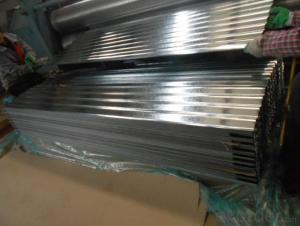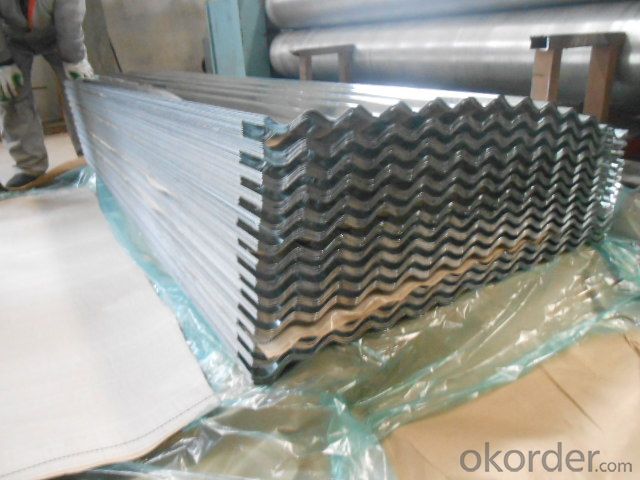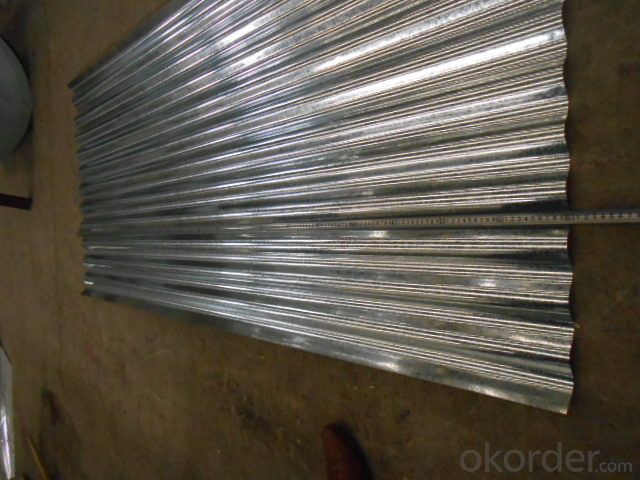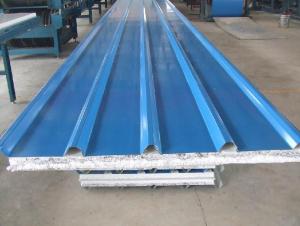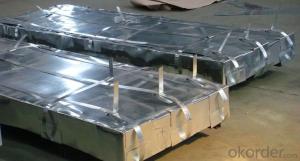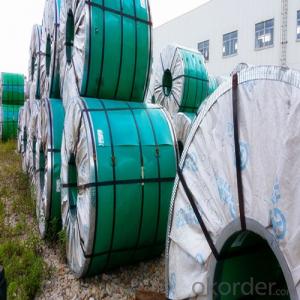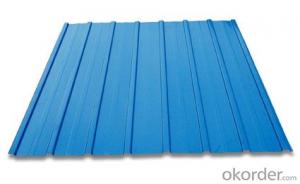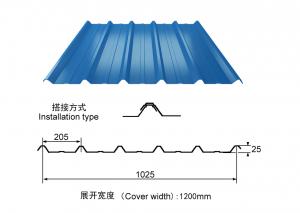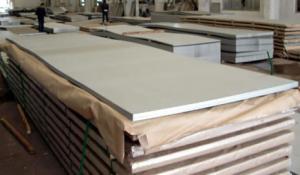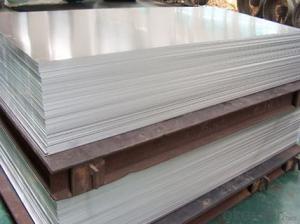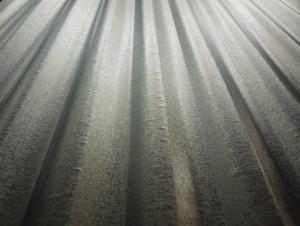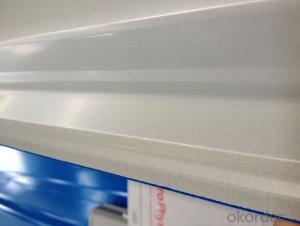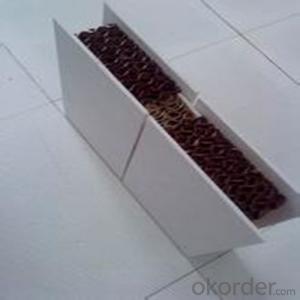CORRUGATED STEEL SHEET
- Loading Port:
- China Main Port
- Payment Terms:
- TT OR LC
- Min Order Qty:
- -
- Supply Capability:
- -
OKorder Service Pledge
OKorder Financial Service
You Might Also Like
CORRUGATED STEEL SHEET
Corrugated steel sheets is the colored steel plate which has been wave formed with the cold rolling treatment, trough especial coated dispose, the color coated steel panel’s guaranty is 12-15 years.
Pressing steel panel with the clear line, and many colors for choice, suitable for any different building style materials, achieving satisfy effects;
Pressing steel panel can be freely incised, it can satisfy the especially designing demands. It apply on convenient construction, and anti-seismic performance, fire proof, waterproof, free of maintenance, ect.
It has been widely applied on civil construction like storerooms, special building roof and walls of wide-span steel structure building and so on.
STEEL GRADE & STANDARD:JIS G3302 SGCC
ZINC COATING MASS:Z40(+/-10g)
SIZE:0.2*900*2000MM
PACKAGE TYPE:PACKED WITH STEEL PALLET
BUNDLE WEIGHT:AROUND 3MT
- Q: What are the common thicknesses for stainless steel sheets?
- Common thicknesses for stainless steel sheets range from 0.4mm to 6mm, with the most commonly used thicknesses being 0.8mm, 1mm, 1.2mm, 1.5mm, and 2mm.
- Q: Can steel sheets be used for manufacturing storage cabinets?
- Yes, steel sheets can be used for manufacturing storage cabinets. Steel is a durable and strong material that is commonly used in the construction of cabinets due to its ability to withstand heavy loads and provide long-lasting storage solutions. Additionally, steel sheets can be easily fabricated into various shapes and sizes, making them suitable for manufacturing cabinets of different dimensions.
- Q: What are the different sheet metal cutting techniques for steel sheets?
- There are several different sheet metal cutting techniques that can be used for steel sheets. Some of the most common methods include shearing, laser cutting, plasma cutting, and waterjet cutting. Shearing involves the use of a mechanical shear to cut the steel sheet along a straight line. Laser cutting uses a high-powered laser beam to melt and vaporize the steel, creating a precise and clean cut. Plasma cutting utilizes a plasma torch to heat and melt the steel, while a high-velocity jet of ionized gas blows the molten metal away. Waterjet cutting involves the use of a high-pressure stream of water mixed with abrasive particles to erode and cut through the steel sheet. Each technique has its own advantages and limitations, depending on factors such as the thickness of the steel, desired precision, and cost considerations.
- Q: What are the different color options available for steel sheets?
- Steel sheets can be available in a variety of color options, depending on the specific requirements and preferences. Some common color options for steel sheets include: 1. Natural Steel: This is the most common color option for steel sheets, which is the natural color of the steel surface without any additional coating or treatment. It has a silver-grey appearance. 2. Galvanized Steel: Galvanization is a process in which a protective zinc coating is applied to the steel sheet. This results in a shiny silver color, providing enhanced corrosion resistance. 3. Coated Steel: Steel sheets can be coated with various materials to provide different colors and additional protection. These coatings can include polyester, silicone polyester, polyvinylidene fluoride (PVDF), or plastic film coatings. These coatings can be available in a wide range of colors, including white, red, blue, green, and more. 4. Painted Steel: Steel sheets can also be painted with various types of paint, such as epoxy, polyurethane, or acrylic. This allows for a virtually unlimited range of color options, including standard colors like black, grey, white, as well as custom colors to match specific requirements. It is important to note that the availability of different color options may vary depending on the specific supplier and the intended application of the steel sheets. Additionally, different color options may also have different performance characteristics, such as improved resistance to UV radiation or enhanced durability.
- Q: What are the common thicknesses for aluminum-coated steel sheets?
- The common thicknesses for aluminum-coated steel sheets range from 0.015 inches to 0.125 inches.
- Q: What are the common sizes of steel sheets available in the market?
- The common sizes of steel sheets available in the market vary, but some standard sizes include 4x8 feet, 5x10 feet, and 6x12 feet. These sizes are widely used in construction, manufacturing, and various industries for their versatility and ease of handling. However, it's important to note that steel sheets can also be custom cut to specific dimensions based on individual project requirements.
- Q: How do steel sheets compare to stainless steel sheets in terms of corrosion resistance?
- Steel sheets and stainless steel sheets differ significantly in terms of corrosion resistance. While steel sheets are susceptible to rust and corrosion when exposed to moisture and certain environmental conditions, stainless steel sheets are specifically designed to resist corrosion. Stainless steel contains a higher percentage of chromium, which forms a protective layer on its surface, preventing rust and corrosion. Therefore, stainless steel sheets offer superior corrosion resistance compared to regular steel sheets.
- Q: How are steel sheets protected against rusting?
- Corrosion protection is employed to safeguard steel sheets against rusting. Several techniques are utilized for this purpose: 1. Galvanization: Zinc is applied as a coating on the steel sheets. Acting as a sacrificial anode, the zinc corrodes in lieu of the steel when exposed to moisture or oxygen. Consequently, a barrier is formed to shield the steel from rust. 2. Painting: A layer of paint is applied to the steel sheets, creating a protective barrier against moisture and oxygen. This physical barrier prevents contact between these elements and the steel, thus reducing the likelihood of rust formation. 3. Powder coating: Dry powder is spread onto the steel sheets and then heated to establish a protective layer. The powder liquefies and fuses into a smooth coating, offering remarkable resistance to rust and corrosion. 4. Electroplating: The steel sheets are immersed in a bath containing a metal coating solution, such as zinc or chromium. By passing an electric current through the bath, the metal coating bonds with the steel, serving as a safeguard against rust. 5. Phosphating: A chemical process deposits a layer of zinc or manganese phosphate onto the steel sheets. This layer enhances the adhesion of paint or other coatings, providing a surface resistant to corrosion. These techniques find widespread usage in various industries to avert the rusting of steel sheets. The selection of a specific method is contingent upon factors such as cost, durability requirements, and the intended environment for the steel sheets.
- Q: Can steel sheets be used for manufacturing storage tanks?
- Yes, steel sheets can be used for manufacturing storage tanks. Steel is a commonly used material for storage tanks due to its strength, durability, and resistance to corrosion. Steel sheets can be shaped, welded, and coated to meet the specific requirements of storage tank construction.
- Q: Are steel sheets resistant to corrosion?
- Yes, steel sheets are generally resistant to corrosion due to the protective layer formed by the presence of chromium.
Send your message to us
CORRUGATED STEEL SHEET
- Loading Port:
- China Main Port
- Payment Terms:
- TT OR LC
- Min Order Qty:
- -
- Supply Capability:
- -
OKorder Service Pledge
OKorder Financial Service
Similar products
Hot products
Hot Searches
Related keywords
